This paper investigates the inflation dynamics of Germany, Italy, Finland, the whole Europe Area and the United States, based on a General-Method of Moments (GMM) estimation. The New-Keynesian Model and the Real-Business-Cycle Model are essential for the estimation.
Inhaltsverzeichnis (Table of Contents)
- Introduction
- Stating a Standard New Keynesian Model
- The Representative Household
- The Price Setting Problem of the Representative Firm
- The Role of the Central Bank
- Log-Linearizing the Equations Characterizing the Equilibrium
- Phillips Curve Analysis
- Original Phillips Curve
- Baseline New Keynesian Phillips Curve
- Hybrid New Keynesian Phillips Curve
- Inflation Dynamics and Price Rigidity Analysis
- Data
- Baseline Model Estimation
- Baseline-Estimation Set-Up
- Parameter Calibration
- Results
- Hybrid Model estimation
- Hybrid-Estimation Set-Up
- Results
- Inflation Targeting Approach
- Model Set-Up
- One-Month Inflation Targeting Approach
- Four-Months Inflation Targeting Approach
- Inflation Targeting Europe vs. United States
- Conclusion
Zielsetzung und Themenschwerpunkte (Objectives and Key Themes)
This paper investigates the inflation dynamics of Germany, Italy, Finland, and the European Monetary Union as a whole, as well as the United States. The main objective is to analyze the heterogeneity in inflation dynamics across these regions and to understand the implications for monetary policy.
- Heterogeneity in inflation dynamics across different countries and regions.
- Price stickiness and its role in shaping inflation dynamics.
- The impact of different price setting behaviors on monetary policy.
- The design of optimal inflation-targeting strategies for the European Central Bank.
- The implications of price rigidity for the effectiveness of monetary policy.
Zusammenfassung der Kapitel (Chapter Summaries)
- Introduction: This chapter introduces the main research question, which focuses on the heterogeneity of inflation dynamics within the Eurozone. The paper aims to investigate the different price components and characteristics of three representative Eurozone countries: Germany, Italy, and Finland. The chapter also provides a brief overview of the New Keynesian Phillips Curve (NKPC) and its role in understanding inflation dynamics.
- Stating a Standard New Keynesian Model: This chapter presents a simple standard New Keynesian model without capital. It describes the behavior of the representative household, firm, and central bank. The chapter focuses on the key equations that characterize the equilibrium of the model and the role of price stickiness in determining inflation.
- Phillips Curve Analysis: This chapter discusses the evolution of the Phillips Curve, from the original Phillips Curve to the baseline New Keynesian Phillips Curve and the hybrid New Keynesian Phillips Curve. It provides a theoretical framework for understanding the relationship between inflation, output, and price setting behavior.
- Inflation Dynamics and Price Rigidity Analysis: This chapter presents the empirical analysis of inflation dynamics and price stickiness in Germany, Italy, Finland, and the United States. It estimates the degree of price rigidity using a Generalized Method of Moments (GMM) estimation and compares the results across different countries and regions. This chapter also investigates the differences in inflation dynamics between the baseline and hybrid NKPC models.
- Inflation Targeting Approach: This chapter explores the implications of the estimated price rigidity for the design of optimal inflation-targeting strategies for the European Central Bank. It considers different inflation-targeting approaches, including a one-month and a four-month approach. The chapter also discusses the importance of accounting for the heterogeneity of the Eurozone member countries when setting monetary policy.
Schlüsselwörter (Keywords)
This paper focuses on inflation dynamics, price rigidity, New Keynesian Phillips Curve, monetary policy, inflation targeting, heterogeneity, Eurozone, and the European Central Bank. The research utilizes empirical methods, such as Generalized Method of Moments (GMM) estimation, to analyze the dynamics of inflation and price setting behavior across different countries and regions.
- Quote paper
- Marc Kern (Author), 2015, Inflation Dynamics Reconsidered. Inflation Targeting Europe vs. United States, Munich, GRIN Verlag, https://www.grin.com/document/317626



